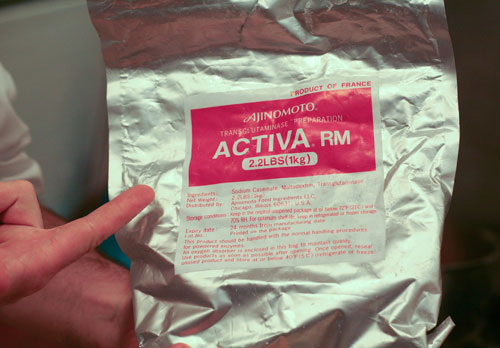posted by Nastassia Lopez

We have a brand new Meat Glue (Transglutminase)Â Primer up on the Cooking Issue’s Primers page!
Here are some excerpts to get you started:
What is Meat Glue? Transglutaminase (TG or TGase), better known to chefs as “Meat Glue,†has the amazing ability to bond protein-containing foods together. Raw meats bound with TG are often strong enough to be handled as if they were whole uncut muscles. TG is safe, natural, and easy to use. In the kitchen, TG is primarily used to:
• Make uniform portions that cook evenly, look good, and reduce waste
• Bind meat mixtures like sausages without casings
• Make novel meat combinations like lamb and scallops

Testing Meat Glue: There is a way to test if your meat glue is still working. Get a small scrap of raw meat (we use chicken). Apply a liberal amount of meat glue to the meat and massage it in. Sniff the meat (don’t inhale the powder). If the meat smells like a wet dog or a wet wool sweater, your glue is good. If it doesn’t, your glue is bad. The next time you get a fresh shipment of TG, run the “wet dog†again and get a sense for how strong the smell is. After a while you will be able to tell how good your glue is (how high the enzymatic activity is) by how strong the wet dog smell is. Don’t wait too long to sniff after you massage in the glue because the smell dissipates after a couple of minutes. The wet dog smell is, I believe, caused by the small amount of ammonia released in the TG reaction.
Can’t get enough? Want more on Meat Glue uses, safety, storage and unique protein binding combinations? Check out the entire Primer!

This was also just posted today..
http://www.madridlab.net/melonas/?p=523
Nice timing.
you know im doing this tmrw
But how do you test meat glue if you are trying to use it on a wet dog?
so here we go… this worked for me the first time i tried it. one scallop, the top leaf of a leek, odorless, flavorless, colorless, soy protien powder( gen soy brand), activa gs.
i first cut the leek green to perfectly fit around the side of the scallop, then made a rough slurry of soy protine powder and water. put the mix with the leek green in a vac seal bag. in an attemp to compress the protine into the leek. let sit over nite. then next day made slurry of TGGS 3-1 water. took the leek from the bag and let it dry off under the heat lamp, then spread the TGGS slurry on leek and wrap around scallop. vacume seal on hi refridgerate over nite.
it was one of those ureaka moments, but the leek was raw so when cooked sous vide the scallop would over cook before the leek would get close to being done, and they both need to cook at seperate temps. searing only the leek would work, but then i would have “browned” leek, not green.
so i have tried again and again with different types of veg, different meats, blanched and unblanched. all to fail. i know why it worked the first time, scallops along with other shell fish have twice as much protine levels as beef does per gram. leek greens have the second highest amount of lysein in green vegtables.
useing powdered lysine, cystine didnt help either. so i talked with bob at ajinmoto about this and he said that it would not work. we talked abit he explianed why and i explained that it did. so he said dont give up, alot of chefs have tried it and it has not worked.
here is where i am at now…. instead of copmressing the soy into the blanched leek, airate it into it. compression will compress broken cell walls in the blanched leek, i want to open them up to absorbe the soy. i have not tried the other types of TG due to being VERY buisy, but assume TGRM would work well (bob said try it).
i tried freeze blanching, i tried blanching in protine saturated water, shocking in protine saturated water , all i can gather is that the cells are to denatured to hold the protine . if you want to try it, please do. let me know how it works, try the parragraph above, thats what i have not tried yet.
i would like to attempt a scallop and leek terrine that could be served hot. so blanched, vibrant green leeks is a must.
is there a form of glue that works on vegetables?
imagine a hollowed strawberry filled with custard with it’s top glued back on to look just like a fresh one…..awesome!
Howdy David,
Wylie Dufresne uses a gelatin mix to glue vegetable purees together with TG into heat-stable noodles. I know that works quite well but doesn’t solve your problem. Derek, who has commented on this primer, is trying to impregnate leeks with soy protein to make them glue together. I don’t know what kind of luck he is having. That also wouldn’t help you because strawberries are irreversibly mangled by the vacuum infusion process. So I guess the answer is yes and no!
someone in the lab pointed out that tissue transglutaminase (tTG) has been associated with celiac sprue (as in, it is the autoantigen thought to be associated with triggering the immune response that manifests as celiac sprue). is activa the same type of transglutaminase? are there different types of transglutaminase? can’t find documentation about this on the ajinomoto website.
Ha Ha yes, the Ajinomoto website doesn’t get into that sort of thing although I did read something they put out that recoomended not using TG for cereal products to be consumed by Celiacs till everything is sorted out. Tissue transglutaminase is different from mTG is several respects. The most interestin article on mTG and Celiac disease is “Transamidation of Wheat Flour Inhibits the Response to Gliadin of Intestinal T Cells in Celiac Disease,” Carmen Gianfrani, et al. Gastroenterology 2007; 133: 780-789
Great article.
Don´t forget that transglutaminase can be made
gelatin heat- resistant. It is nice. Straight mixture works to 80 Grad. More is as good as enought.
Greetings from germany
Alexander
We are wondering if the glue will work if the meat (in our case, lamb) has been rolled in herbs? Will that prevent bonding?
Hi Suzanne,
As long as meat touches meat transglutaminase will work. The herbs will not bond directly. Your bond probably won’t be as strong as one without herbs. If meat doesn’t touch meat you have a problem. I might be able to solve that problem but it is more difficult. Please advise.